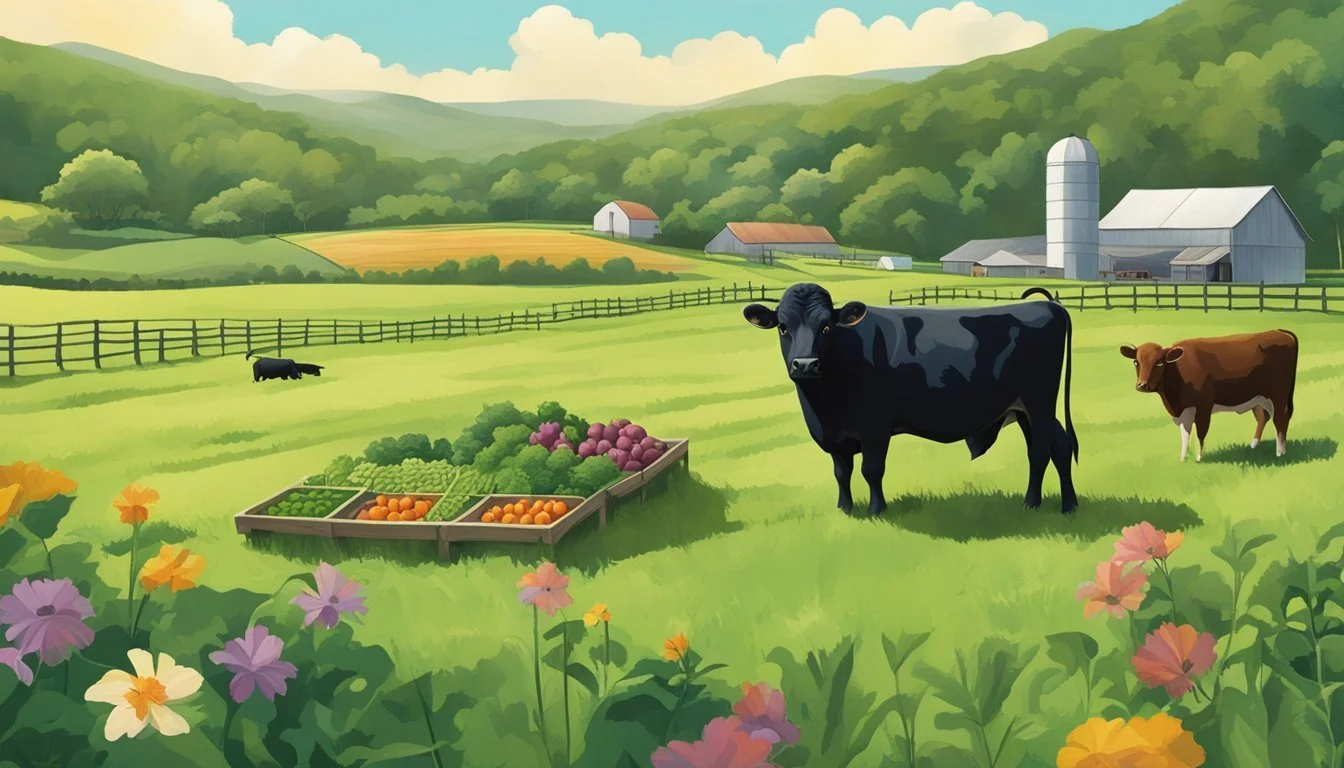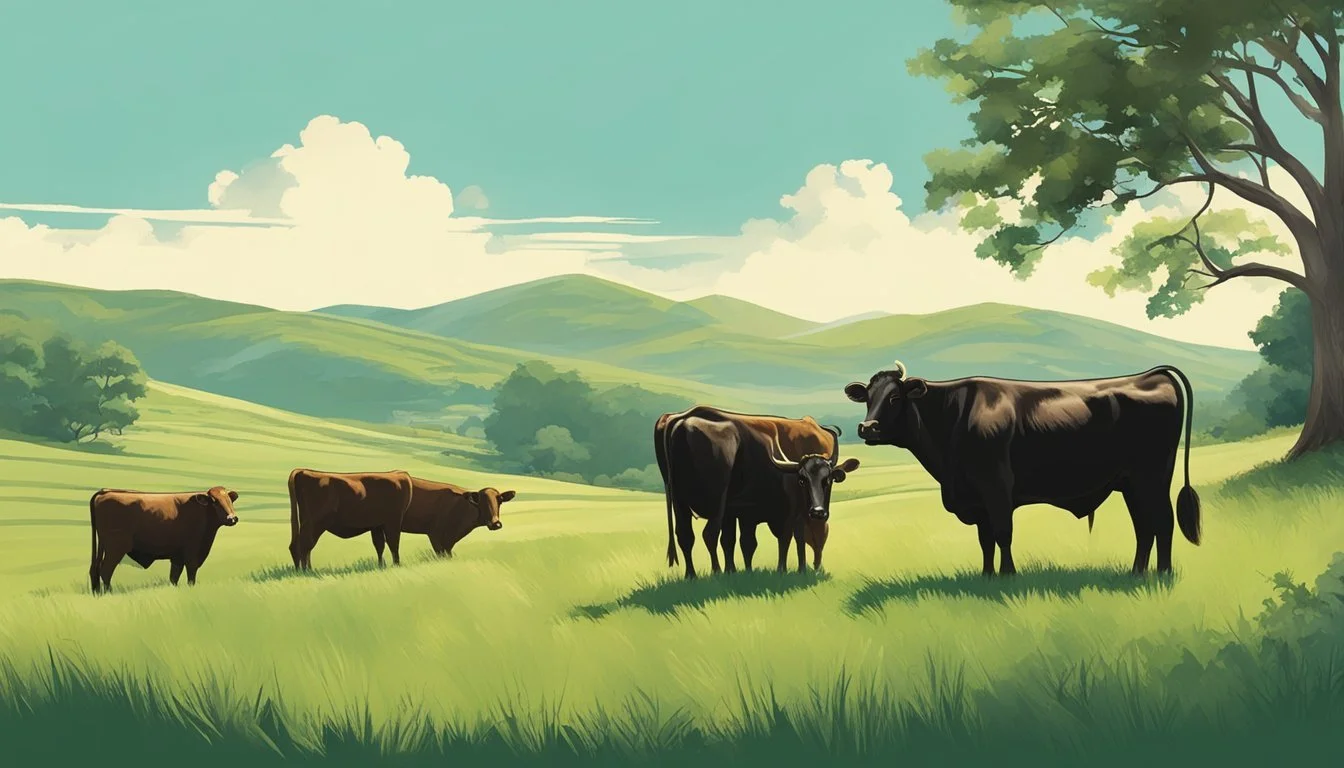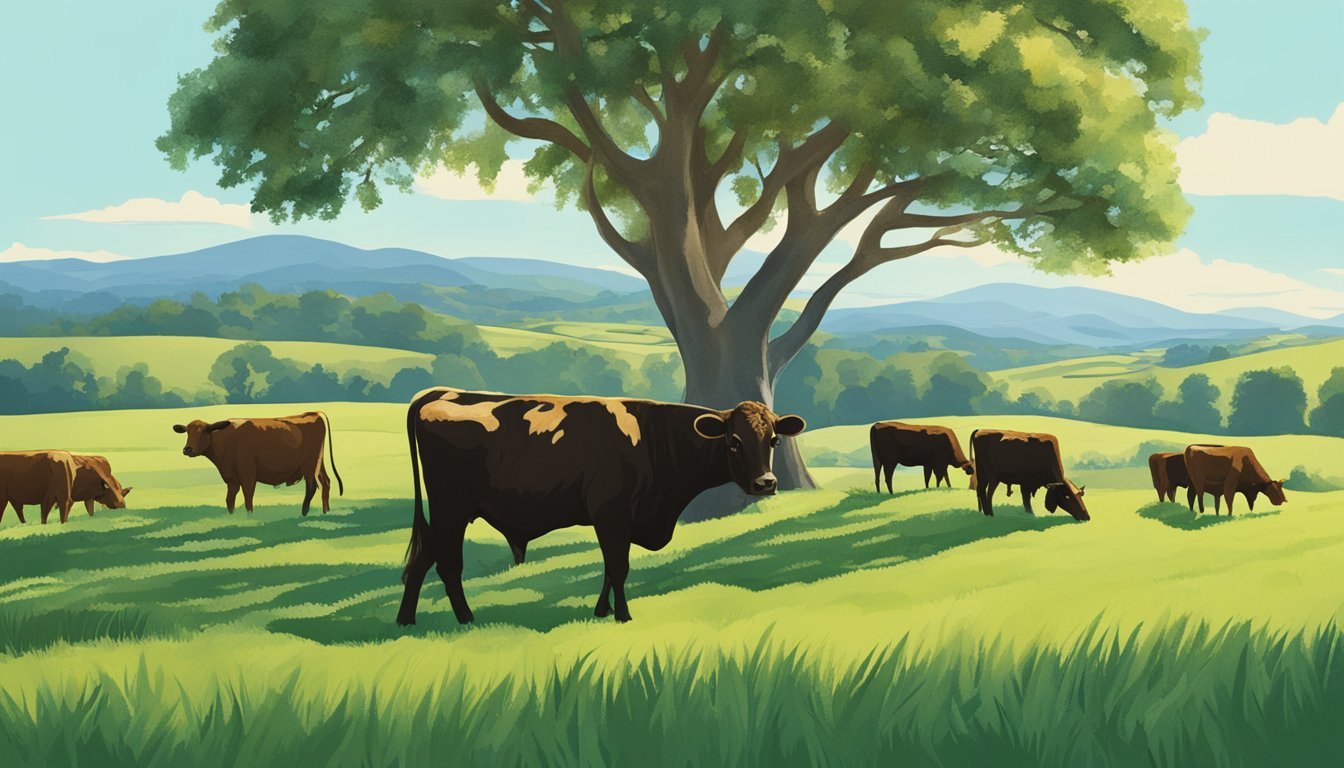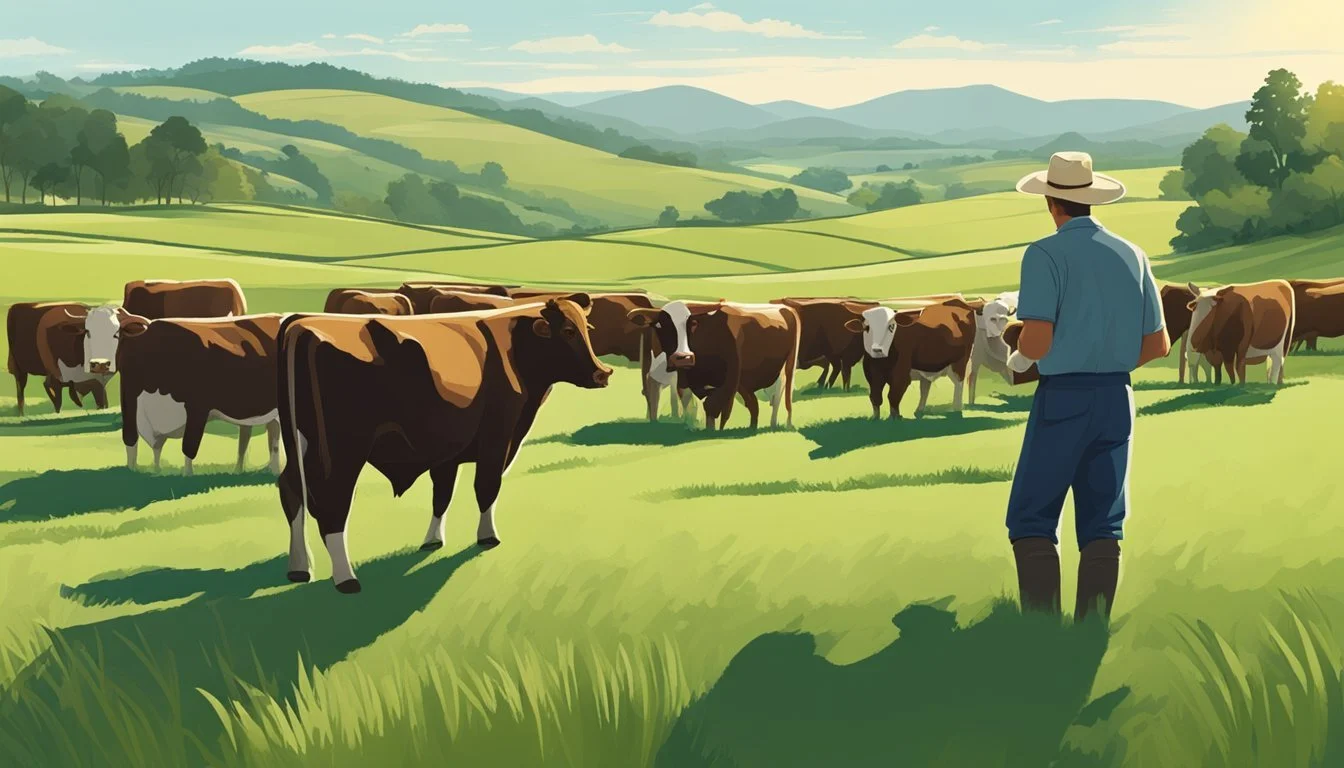Dexter Cattle and the Slow Food Movement
How They Support Sustainable Diets
Dexter cattle, a breed known for its versatility and suitability for small-scale farming, have become emblematic of sustainable agricultural practices that are aligned with the Slow Food Movement's principles. This movement champions the consumption of local and traditionally-produced foods, advocating for a food system that is environmentally sustainable, socially just, and economically fair. As conscious consumers increasingly demand food sources that are both environmentally responsible and supportive of local communities, Dexter cattle offer a compelling solution. Their relatively small size, efficient feed conversion, and ability to thrive on pastures make them an attractive choice for farmers committed to local, sustainable food production.
The Slow Food Movement, initiated in 1989, was established as a counteraction to the proliferation of fast food and the loss of local food traditions. By focusing on 'good, clean, and fair' food, the movement underlines the importance of nourishing produce that is kind to the planet and its inhabitants. Dexter cattle play a pivotal role in this movement, as they are often raised on small farms that prioritize the maintenance of genetic diversity, heritage livestock breeds, and gentle land management. This aligns with the movement's goal of preserving traditional and regional cuisine and encourages farming methods that protect ecosystems and biodiversity.
In the context of sustainable eating, Dexter cattle contribute to the tenets of locally-sourced diets, which can enhance food security and reduce the carbon footprint associated with long-distance food transportation. The consumption of Dexter beef, a high-quality heritage meat, supports local economies and connects consumers to their food sources. The interconnectivity of Dexter cattle farming, the Slow Food Movement, and sustainable consumption forms a synergy that promotes a shift towards more thoughtful and deliberate food choices. As more individuals become aware of their dietary impact on the world, embracing Slow Food principles through the support of sustainable livestock practices exemplified by Dexter cattle is gaining traction.
Origins and Characteristics of Dexter Cattle
Dexter cattle play a pivotal role in the movement toward local, sustainable agriculture, thanks to their Irish heritage and adaptability to small, diversified farming practices.
History and Development
Dexter cattle hail from Ireland, with early records pointing to their presence in the southern regions, particularly in County Kerry. Small landholders developed this breed in the early 1800s for dual purposes: milk and meat production. Over time, their numbers grew, solidifying their presence in Irish agriculture.
Irish Origins: Southwest Ireland (County Kerry, County Tipperary)
Development: Bred in the early 19th century by smallholders
Livestock Registers: Recorded in English herd books by the late 19th century
Physical Traits and Varieties
Dexter cattle are distinguished by their notably smaller stature, robust build, and versatility. They are mainly found in three solid colors: black, dun, and red. This breed possesses a naturally horned disposition, although polled variants also exist due to selective breeding.
Stature: Small size
Color Varieties: Black, Dun, Red (all solid colors)
Horn Status: Typically horned, but polled (naturally hornless) varieties are also present
Differences from Other Cattle Breeds
Dexters are considerably smaller than many mainstream cattle breeds, making them particularly well-suited for small farms. Unlike larger cattle breeds which often require extensive land and resources, Dexters are efficient on smaller plots, showcasing their sustainability as a livestock choice.
Farm Size: Ideal for small farms
Resource Efficiency: Lesser resource requirements compared to larger breeds
Sustainable Practices: Conducive to local food systems and sustainable eating movements
The Slow Food Movement
The Slow Food movement is internationally recognized for its commitment to preserving cultural heritage through local food traditions. It emphasizes the significance of consuming good-quality, environmentally sustainable, and ethically produced food that is fair for both consumers and producers.
Principles of Slow Food
The core principles of Slow Food revolve around maintaining a food system that is sustainable and just. The movement seeks to protect cultural identities linked to culinary traditions while advocating for biodiversity and ecological harmony in food production.
Key Aspects of Slow Food Principles:
Preservation of traditional and regional cuisine
Encouragement of farming characteristic to the local ecosystem
Education on the importance of nutritional quality and food variety
Good, Clean, and Fair Food
At the heart of the movement lies the triad of 'good, clean, and fair':
Good: Food should be flavorsome and healthy, enhancing the consumer's experience.
Clean: Sustainable farming methods are pivotal, aimed at reducing environmental impact.
Fair: Social justice for both producers and consumers is fundamental, with fair conditions and compensation for growers.
This framework supports a food system that values dietary diversity and tastes inherent to different cultures, while also ensuring ethical business practices.
Terra Madre Salone del Gusto
The Terra Madre Salone del Gusto is a biennial event hosted by Slow Food that gathers small-scale farmers, food producers, and enthusiasts. It serves as a platform to share experiences, strategies, and products, echoing the movement's philosophy on an international stage.
At Terra Madre, participants engage in:
Showcasing local foods and exchanging culinary practices
Learning about the impact of food choices on the environment
Connecting with a network of individuals committed to transforming the food system
The event underlines the interconnectedness of global food cultures and the importance of solidarity in protecting food heritage.
Sustainable Farming Practices
Sustainable farming practices are pivotal for the continuation of local food systems and the environment. Emphasizing sustainable livestock raising and land management, these practices benefit both biodiversity and soil health.
Role of Small-scale Livestock Farming
Small-scale livestock farming, as seen in the case of Dexter cattle, plays a crucial role in sustainable development. These animals are well-suited for low-input farming systems due to their small size, hardiness, and dual-purpose nature, providing both meat and milk. Dexter cattle farmers often employ pasture-based systems that conserve resources and reduce overhead costs, emphasizing the sustainability of the practice.
Agroecology and Biodiversity
Agroecology is integral to maintaining biodiversity within farmlands. The fostering of diverse ecosystems through agroecological methods not only supports various plant and animal species but also enhances the resilience of the farm to diseases and climate extremes. Farms practicing agroecology maintain a balance by integrating livestock like Dexter cattle, which in turn support the health and variety of the ecosystem.
Key benefits to biodiversity:
Supports a range of species
Promotes natural balance and resilience
Increases genetic diversity of agricultural species
Soil Health and Crop Rotations
Maintaining soil health is a cornerstone of sustainable farming, with crop rotations being one of the effective practices in this realm. Rotating crops helps prevent soil depletion, reduces the risk of pest infestations, and can improve soil fertility over time.
Advantages of crop rotations:
Enhances soil structure and organic matter
Breaks pest and disease cycles
Enables better water infiltration and retention
By incorporating animals such as Dexter cattle into the crop rotations, manure can serve as a natural fertilizer, thereby reducing reliance on chemical inputs and closing the nutrient cycle on the farm.
Through these approaches, farmers contribute to sustainable development goals by ensuring that their land remains productive and healthy for future generations, while also conserving the environment.
Environmental Impacts
The introduction of Dexter cattle in the Slow Food Movement reflects a growing recognition of the breed's potential to mitigate environmental impacts associated with conventional livestock farming, particularly in the areas of greenhouse gas emissions, carbon footprint reduction, and effects on local ecosystems.
Greenhouse Gas Emissions
Dexter cattle produce less methane per animal compared to larger dairy and beef breeds. Methane (CH4) is a potent greenhouse gas with a significant impact on climate change. By virtue of their smaller size, Dexters require less feed, which translates to a lower production of methane during digestion—a process known as enteric fermentation.
Key facts:
Methane Emissions: Substantially lower in Dexter cattle compared to larger breeds.
Cause: Reduced volume of feed and smaller size of the digestive system.
Carbon Footprint Reduction
When managed appropriately, Dexter cattle contribute to the reduction of the carbon footprint of agricultural practices. Their adaptability to diverse and marginal lands means that they can be raised on pastures unsuitable for intensive agriculture, thus preserving natural ecosystems and promoting soil carbon sequestration.
Contributing factors:
Land Use: Dexter cattle's ability to thrive on less arable land.
Soil Health: Enhancement due to grazing patterns conducive to carbon sequestration.
Impact on Local Ecosystems
Dexter cattle play an important role in sustaining local ecosystems. Their grazing habits can improve soil quality and biodiversity which, in turn, benefits wildlife habitats. Additionally, localized Dexter farming reduces the need for long-distance transportation of livestock and feed, leading to a drop in air pollutants commonly associated with food shipping.
Principal benefits:
Soil and Biodiversity: Grazing improves soil structure and enriches local flora and fauna.
Reduction in Air Pollutants: Decreased reliance on transport reduces emissions of air pollutants.
Benefits of Dexter Cattle in Local Food Systems
Dexter cattle bring distinct advantages to local food systems, enhancing resilience to climate events, showcasing efficiency and adaptability, and bolstering community and cultural significance.
Resilience to Climate Events
Dexter cattle are robust against various climate-related challenges, making them suitable for local food systems focused on sustainability. They can withstand drought conditions better than many larger breeds due to their smaller size and efficient water utilization. Additionally, their hardy nature equips them to survive in adverse weather, such as storms, with greater ease. This resilience contributes to a steadier supply of local food even in unpredictable climates.
Efficiency and Adaptability
A notable benefit of Dexter cattle is their dual-purpose nature, providing both quality beef and rich, butterfat milk efficiently. Their small stature means they require less space and food, translating to lower maintenance costs and higher adaptability to diverse environments. These traits are particularly valuable for smaller farms or those with limited resources, as they can produce a significant yield without the extensive resources larger breeds demand.
Average milk production: 1.5 to 2.5 gallons per day
Butterfat content: 4%, comparable to Jersey cattle
Community and Cultural Significance
Integrating Dexter cattle into local food systems supports the community by promoting connections between farmers, consumers, and the land. The proximity of consumers to their food source fosters a deeper understanding of where their food comes from and the labor that goes into producing it. The presence of Dexter cattle also contributes to preserving cultural traditions related to farming and livestock care, passing down knowledge and practices that have shaped rural livelihoods for generations.
Food Security and Nutrition
Dexter cattle play a pivotal role in enhancing local food security and offer a nutritionally rich option in beef and milk. Their smaller size and efficient milk production make them well-suited to sustainable farming practices, which contributes positively to the local food systems.
Contribution to Food Security
Dexter cattle are hardy and adaptable, making them suited for diverse climates and environments. They effectively convert grass into meat and milk, requiring less feed than larger breeds, which assists farmers in maintaining a more sustainable operation. When it comes to enhancing food security, Dexter cattle offer several advantages:
Their modest size allows for more animals per acre, thereby increasing the potential yield of food from the same space.
Dexter cattle can thrive on pasture that might not be suitable for other agricultural purposes, thereby making use of land that might otherwise be unproductive.
By being part of small-scale farming operations, they support local food systems and reduce dependency on large-scale industrial farms.
Nutritional Value of Dexter Beef and Milk
Dexter beef is known for its high quality, being both tender and flavorful. It is a good source of essential nutrients such as:
Protein: Essential for building and repairing tissues.
Iron: Important for blood health and energy levels.
B-vitamins: Necessary for various metabolic processes.
Milk production from Dexter cows, while lower in quantity than larger dairy breeds, is high in quality. The milk has a higher butterfat content, which is linked to various benefits:
Rich in omega-3 fatty acids, known for reducing heart disease risk.
Contains higher levels of beta-carotene and conjugated linoleic acid (CLA) which has been associated with various health benefits, including anti-carcinogenic properties.
This combination of beef and milk from Dexter cattle offers a nutrient-dense option for consumers, while supporting sustainable agricultural practices.
Challenges and Considerations
Promoting Dexter cattle within the Slow Food Movement presents unique challenges and considerations, especially in the realms of market access, economic viability, and animal welfare. These considerations are pivotal to the success of integrating Dexter cattle into local, sustainable food systems.
Market Access and Distribution
Market Access for Dexter cattle products hinges on the ability to reach consumers who value local, sustainable meat and dairy. Despite increased consumer interest, these producers often encounter:
Limited distribution channels: Small-scale producers may struggle to connect with mainstream markets, often relying on farmers' markets or community-supported agriculture (CSA) models.
Packaging constraints: Sustainable packaging solutions are desired by eco-conscious consumers, but may come with higher costs or limited availability.
Economic Profitability and Costs
The Economic Profitability of raising Dexter cattle for local markets is a critical concern. Key factors affecting profitability include:
Production costs: Feed, veterinary care, and labor are major expenses. Efficient management is necessary to maintain a healthy balance sheet.
Rural Communities' impact: Dexter cattle farming can provide economic opportunities in rural areas, but it requires sufficient demand and sensible pricing to ensure the long-term profitability for farmers.
Breeding and Animal Welfare
Breeding Practices and Animal Welfare considerations are fundamental to maintaining the integrity of the Slow Food Movement's values:
Calving Difficulties: Occasionally, Dexter cattle may present challenges during calving which require careful monitoring and intervention to ensure the well-being of both dam and offspring.
Consideration for Udders and Handling:
Udder health is paramount, necessitating attentive care and potentially impacting milking efficiency.
Dexter cattle, known for their docile temperament, still require proper handling to ensure safety and minimize stress for both the animals and handlers.
By addressing these challenges and considerations thoughtfully and proactively, supporters of the Slow Food Movement can work towards fostering a sustainable future that respects both the welfare of Dexter cattle and the needs of rural communities.
The Future of Dexter Cattle and Slow Food
The resurgence of Dexter cattle, combined with advocacy for the Slow Food movement, is expected to play a crucial role in shaping sustainable eating habits. This future scenario encapsulates the public’s growing appetite for local, eco-friendly food sources, and the potential policy shifts that support this trend.
Public Perception and Diet Trends
Public interest in sustainable eating is on the rise, with increasing awareness of the environmental impact of meat consumption. Dexters, as a hardy, compact breed, are well-suited for small-scale farming and local meat production. Their ability to thrive on grass and produce high-quality, well-marbled meat is aligning with consumer preferences for eating locally and reducing food miles. The trend indicates a pivot towards diets that favor locally sourced meats—such as Dexter beef—that support food system sustainability.
Policy Development and Advocacy
Policy development is pivotal in advocating for sustainable diets. Legislation that incentivizes sustainable practices could impact Dexter cattle farming positively. Advocacy groups are increasingly calling for policies that align with the United Nations' Sustainable Development Goal 2 (SDG2), aiming to end hunger and promote sustainable agriculture. Dexter cattle may benefit from policies that support small herds and grass-fed meat production as part of social sustainability.
Expanding the Role of Dexters in Sustainable Diets
In a shifting food landscape, the Dexter breed could play a significant role in sustainable diets. Their efficient meat and milk production make them a practical choice for farmers seeking to minimize waste and maintain food system sustainability. Including legumes in crop rotations for pasture can also enhance soil health while providing excellent nutrition for the cattle. As the Slow Food movement gains traction, the Dexter’s stature as a versatile and eco-friendly option could see its inclusion in a sustainable diet lexicon that values diversity and sustainable eating.








